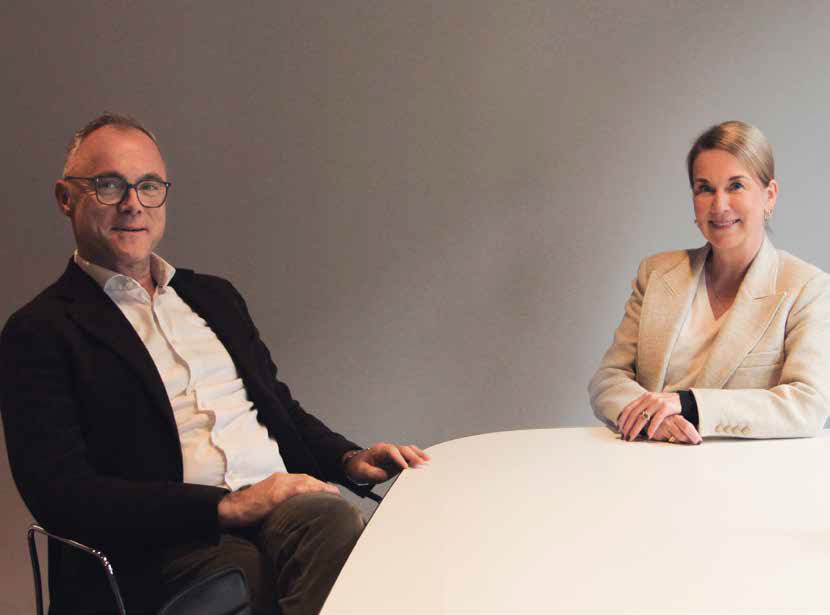
Hamburg
In conversation with Sabine Hupe and Stefan Spilker
„Building in existing structures is pure individualism“
Interview with Sabine Hupe, Managing Partner bicon Generalplanung GmbH, and Stefan Spilker
Interview
In the case of the Hotel Bredeney in Essen and the Parkstadt Mülheim an der Ruhr, the former Tengelmann Group headquarters, bicon Generalplanung GmbH has already been able to prove together with Stefan Spilker that demolition and new construction are not always the only way to deal with obsolete existing buildings. Instead, we build together in the existing stock by revitalizing the building fabric and wherever possible redensifying it. In this way, the new emerges from the old - in the form of marketable properties and entire neighborhoods. In a joint interview, Stefan Spilker and Sabine Hupe explain why good preparation is so important and which sustainability factors play a special role.
Mr. Spilker, do we talk too rarely about sustainable building in existing structures?
Stefan Spilker: Definitely. The topic of Environmental Social Governance (ESG) is clearly shaping the industry - but primarily in new construction, less so in existing buildings. The current certification systems such as DGNB are also tailored to new properties. According to BNP Paribas, however, 80% of the buildings in 2050 are already part of the existing stock. And only 2% of these properties currently meet the "net zero" of the Paris climate targets. That's why we urgently need to do something to renew these building stocks. Of course, this is not possible for all properties, but that is why we need to address the issue all the more urgently and also identify those properties that can be given a second life. Incidentally, I think that building in the existing stock is far more complex than simply constructing new buildings, because you have to get involved with the circumstances. It is of little help to try to transfer existing concepts. Building in the existing stock is pure individualism.
Sabine Hupe: Since every demolition releases an enormous amount of gray energy, it is rightly becoming increasingly difficult to demolish and build anew in Germany. That's why we need to develop a systematic understanding of conversion and building in the existing building stock, on the basis of which we make an individual decision from project to project. In some cases, a combination of revitalization and partial new construction makes sense, as we are realizing together in Mülheim an der Ruhr.
How much can be prepared when building in existing structures - and what is the significance of the respective year of construction?
Sabine Hupe: A thorough preliminary examination is the be-all and end-all. That's why, together with Stefan Spilker, we conducted an extensive technical due diligence (TDD) on the joint project Hotel Bredeney in Essen, paying close attention, among other things, to contaminated sites, fire protection issues and other risks.
Stefan Spilker: It would be highly negligent to take over an existing building without first inspecting it thoroughly. That's why it's also incredibly important for me as a project developer to get the sound opinion of third parties. Of course, market experience also helps to determine the potential risks that buildings from different decades hold for such a project. The dreaded asbestos from the 1970s is just one example of many; even the seemingly fairly new properties from the 1990s have their pitfalls. However, due to the new - and very important - environmental awareness, even properties from the 2000s are now in need of revitalization. As a project developer who has been in business long enough, you may even eventually get the dubious pleasure of developing your own "early work" a second time.
How do you deal with " unpleasant surprises" that you are confronted with when building in existing structures?
Sabine Hupe: Well, the aforementioned TDD is intended to reduce these risks as much as possible. Nevertheless, there will always be moments that were simply not foreseeable beforehand - or else things do not go exactly according to plan. Above all, good communication is elementary. For us in project management, it is important to solve any problems that arise constructively with the project team. This requires careful selection of the planners and specialist planners involved. This also means accepting criticism from time to time, if necessary. The top priority, however, is complete transparency vis-à-vis the project developer and his investors.
Stefan Spilker: From the developer's point of view, however, it is also important to act conservatively and build in financial buffers. The biggest problem would be to view one's own project too ambitiously, because then there is less room for the unforeseen. And I am also sure that good cooperation between the developer and the general planner or project manager is also reflected in the subsequent quality of the buildings - and this also applies quite explicitly to the sustainability factor.